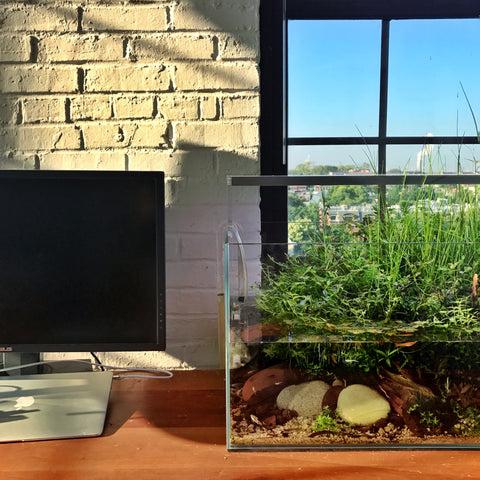
Transitioning Aquatic Plants to Emersed Form - Wabi Kusa
By Chris (@shrimpery)
Most of the aquatic plants we use in the aquascaping hobby are not truly aquatic plants. In nature, you are more likely to find them along a shoreline, often in areas that have fluctuating water levels. Depending on what the situation requires, they are equally adept at surviving underwater or on dry land (ie, moist soil) indefinitely. This makes them different from obligate aquatic plants, which can only survive underwater (one example of a true aquatic is Blyxa). No one would blame you for thinking ‘emersed’ is a typo of ‘immersed,’ but the word immersed is actually another way to describe emergent vegetation that has adapted to life above the water’s surface. Converting emersed plants to underwater use isn’t difficult, but it does take a bit of savvy to avoid ‘melting’ the plants- something that can also happen when submerged plants are introduced to drastically different water conditions than they are used to.
Most plants will not look the same in their submersed forms as they do in their emergent forms; often the difference is so drastic that it is hard to believe both forms are from the same plant. For example, above the surface, most Rotala species have thick, self-supporting stems with round, waxy, bright green foliage. In contrast, under the surface, the same plant will have softer, more narrow leaves and stems, with brighter colors. The softer leaves are to better facilitate gas exchange underwater, while the waxy leaves above the surface are better to prevent the plant from drying out. You can imagine that the waxy leaves would not be best suited to underwater life (and vice versa). Thus, the plant will adapt to the situation it finds itself in by growing new foliage that is a better fit for its new environment.
Some people swear by the ‘dry start method’ for carpeting plants such as Micranthemum tweediei 'Monte Carlo,' but I am not one of them. While it certainly works just fine, in my opinion it confers no extra benefits. The plants still have to adapt to being submerged and grow new foliage; it is much easier to just go ahead and plant the plants into the substrate and then flood the tank as you normally would. In both situations, you may see some ‘melting’ as some of the poorly adapted leaves die away to make room for new growth; don’t despair if this is the case. Unless the whole plant (including the buried portions) is truly dead, it will often quickly grow back in submerged form. To prevent the breakdown of the dead/melting leaves from dumping excess organic wastes into the water (potentially causing an algae outbreak), it is best to manually remove the debris, perhaps trimming off the dead portions with a scissor to avoid disrupting the parts that are still alive. An exception to my avoidance of the dry start method is moss; using dry start for moss (in a humid environment) is a great way to get little bits of moss to grow on driftwood and rocks without having to rely on string or glue to hold it in place. Moss also easily adapts to life underwater.
As always, water parameters are the foundation for success. I have had the best luck adapting emersed plants (such as those found in tissue culture cups) to aquatic conditions when using somewhat acidic, soft water (pH 6.6-7, GH 4-6). Good flow and frequent water changes ensure that the plants can ‘breathe,’ with a steady current providing better gas exchange and oxygen for the plants. Keep in mind that when plants are in their emergent forms, they have easy access to oxygen and, most importantly, atmospheric carbon dioxide, from which they extract carbon to build their tissue and grow. This is why you hear about ‘high tech’ plants- plants that require aggressive carbon dioxide injection often adapt less vigorously to underwater conditions than less fussy plants. In general, however, injecting pressurized carbon dioxide into your tank helps emersed plants grow and adapt more quickly underwater. With that said, many plants will adapt equally well (albeit more slowly) in tanks with no injected carbon dioxide.
Sphaerocaryum is a great example of the dimorphism that can be observed above and below the water. In its emersed form, it forms dense, bushy mats; in its submerged form, it can develop a bright pink coloration and almost resemble a branching stem plant (it is actually a true grass). Alternatively, ‘Monte Carlo’ looks very similar in its submerged and emersed forms. A pond tank is a great way to showcase these sort of transitions that occur at the waters’ edge; you can also let the plants in the back of a tank get very tall until they begin to break the water’s surface and begin to develop emersed stems to exposure to the air.
Tell us - Was this article helpful? Please leave a comment below!
If you have any questions regarding this article, please DM us on Instagram, Facebook, or email support@buceplant.com so we can assist you - @buceplant









Comments
Leave a comment